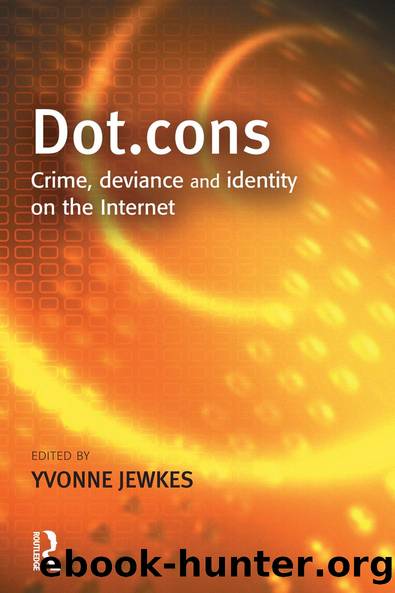Dot.cons by Yvonne Jewkes

Author:Yvonne Jewkes [Jewkes, Yvonne]
Language: eng
Format: epub
ISBN: 9781843920007
Barnesnoble:
Publisher: Taylor & Francis
Published: 2003-01-01T00:00:00+00:00
Biometrics are based upon some physical attribute that is (usually) unique to the individual and which, as such, cannot be removed and misused by an impostor. The most frequently used form of biometric identification is fingerprinting. This has been used to fix identity on offenders since the end of the nineteenth century and has come to be used more recently by some countries for the purposes of controlling immigration (Torpey 2000). Computer systems that store and recognise fingerprints have made the process of identification faster and more certain with one Japanese system claiming to be able to match fingerprints in one second with a 99.9 per cent accuracy rate. But despite the clear potential for the expansion of the use of fingerprints as a means of identification, there is a general reluctance to extend their use for more general identification purposes, possibly due to the connotations of criminality (Clarke 1994).
Among other forms of biometrics being developed with personal identification in mind is hand geometry, a technique used to process frequent travellers to the USA using a system known as INPASS (Immigration and Naturalisation Service Passenger Accelerated Service System). It is a voluntary scheme that allows participants to bypass usual airport procedures thereby reducing processing time to a mere 20 seconds. Participants are required to establish their identity in order to register for this scheme. The palm of the hand is scanned and the image is stored on a smart card. At the airport, the passenger inserts the card into a terminal and places his or her hand on a scanner that compares this with the image stored upon the card. The system has a high accuracy rating and has the potential to be implemented in a range of other situations in which there is a need for a fast and reliable means of establishing identity.
Any system that links identifying information irretrievably with a particular individual has clear benefits for eliminating identity theft. Biometrics are, by and large, unique to an individual. Hence the potential for abuse would appear to be minimal. However, the reliability of any system of identification based upon biometrics could be thwarted by the weaknesses of a registration system based upon documentary identification. As has been outlined earlier, a collection of low-integrity forms of identification can be used to establish a convincing fraudulent legal identity and unless stringent checks are made there would appear to be little to prevent an impostor registering for a scheme such as INPASS that has the appearance of being a wholly reliable means of ascertaining identity. In this way, the weaknesses of low-integrity identification systems are inherited by high-integrity systems, and their apparent infallibility is undermined and eroded.
That said, biometrics have clear advantages over alternative systems of identification in that they appear to be incapable of being misappropriated by impostors as they are linked to a single individual. There is little scope for multiple users of the same biometric identity. Hence such a system has much to offer in terms of reducing the prevalence of identity theft.
Download
This site does not store any files on its server. We only index and link to content provided by other sites. Please contact the content providers to delete copyright contents if any and email us, we'll remove relevant links or contents immediately.
Sass and Compass in Action by Wynn Netherland Nathan Weizenbaum Chris Eppstein Brandon Mathis(7402)
Grails in Action by Glen Smith Peter Ledbrook(7296)
Kotlin in Action by Dmitry Jemerov(4638)
Management Strategies for the Cloud Revolution: How Cloud Computing Is Transforming Business and Why You Can't Afford to Be Left Behind by Charles Babcock(4131)
The Age of Surveillance Capitalism by Shoshana Zuboff(3423)
Learn Windows PowerShell in a Month of Lunches by Don Jones(3243)
Mastering Azure Security by Mustafa Toroman and Tom Janetscheck(3028)
Mastering Python for Networking and Security by José Manuel Ortega(2952)
Blockchain Basics by Daniel Drescher(2891)
TCP IP by Todd Lammle(2640)
Microsoft 365 Identity and Services Exam Guide MS-100 by Aaron Guilmette(2612)
From CIA to APT: An Introduction to Cyber Security by Edward G. Amoroso & Matthew E. Amoroso(2483)
Hands-On Azure for Developers by Kamil Mrzyglod(2412)
Configuring Windows Server Hybrid Advanced Services Exam Ref AZ-801 by Chris Gill(2372)
React Native - Building Mobile Apps with JavaScript by Novick Vladimir(2340)
MCSA Windows Server 2016 Study Guide: Exam 70-740 by William Panek(2313)
The Social Psychology of Inequality by Unknown(2311)
The Art Of Deception by Kevin Mitnick(2298)
Azure Containers Explained by Wesley Haakman & Richard Hooper(2264)
